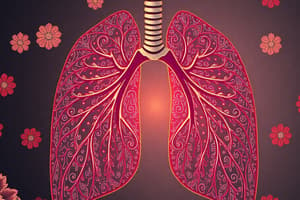Podcast
Questions and Answers
Where does oxygen go after being transported by the blood?
Where does oxygen go after being transported by the blood?
- Muscles for energy production
- Cells in all tissues of the body (correct)
- Skin for absorption
- Stomach for digestion
What is the function of the epiglottis during swallowing?
What is the function of the epiglottis during swallowing?
- Closes the oesophagus to prevent food from entering the trachea (correct)
- Filters the air passing through the nasal cavity
- Helps in sound production
- Helps in warming and humidifying the air
What purpose do the hairs and mucus in the nose serve?
What purpose do the hairs and mucus in the nose serve?
- Regulating blood pressure
- Aiding in the production of hormones
- Trapping debris to prevent it from reaching the lungs (correct)
- Increasing blood oxygen levels
What structures are lined by mucous membranes in the respiratory system?
What structures are lined by mucous membranes in the respiratory system?
What is the function of the larynx in the respiratory system?
What is the function of the larynx in the respiratory system?
Why does the trachea have C-shaped cartilage rings?
Why does the trachea have C-shaped cartilage rings?
Why do all cells in the body need oxygen?
Why do all cells in the body need oxygen?
Which system is responsible for the exchange of gases between the internal and external environments of the body?
Which system is responsible for the exchange of gases between the internal and external environments of the body?
What maintains the efficient exchange of gases in the lungs?
What maintains the efficient exchange of gases in the lungs?
What is one of the functions of the alveoli in the lungs?
What is one of the functions of the alveoli in the lungs?
What would happen if the respiratory system failed to function properly?
What would happen if the respiratory system failed to function properly?
Why is gas exchange crucial at the cell, tissue, and organ levels?
Why is gas exchange crucial at the cell, tissue, and organ levels?
Flashcards are hidden until you start studying
Study Notes
Respiratory System Function
- The circulatory and respiratory systems work together to supply oxygen to cells and remove carbon dioxide from cells.
- This ensures that oxygen and carbon dioxide levels in tissues remain relatively constant.
Structure of the Respiratory System
- The respiratory system includes the nose, trachea, bronchi, and lungs.
- Air enters the body through the mouth and nose.
- The nose and nasal cavity are lined by mucous membranes that warm and humidify the air.
- Hairs and mucus in the nose trap debris, preventing it from entering the lungs.
Nasal Cavity and Pharynx
- The pharynx (throat) is the region between the nasal cavity and the top of the trachea and oesophagus.
- The epiglottis, a flap of elastic cartilage, covers the oesophagus during inhalation and the larynx during swallowing.
Larynx and Trachea
- The larynx (voice box) contains vocal cords that vibrate as air passes over them, producing sound.
- The trachea (windpipe) is made up of C-shaped cartilage rings that keep it open, allowing air to pass through.
- The trachea splits into two branches at its base, one for each lung.
Scientific Inquiry and Investigation
- Identify, research, and construct questions for investigation, and propose hypotheses.
- Design investigations, including procedures, materials, and data collection.
- Conduct investigations safely and competently, and represent data in meaningful ways.
Science as a Human Endeavour
- Lifestyle choices, such as physical activity, diet, and drug use, can affect body functioning in the short and long term.
Science Understanding
- The respiratory system facilitates gas exchange between the internal and external environments of the body.
- The structure and function of the respiratory system at the cell, tissue, and organ levels enable efficient gas exchange in the lungs.
Studying That Suits You
Use AI to generate personalized quizzes and flashcards to suit your learning preferences.




